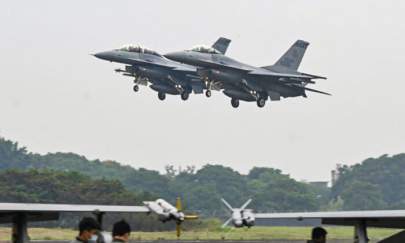Taiwan Claims Chinese Military Helicopter Flew Into Air Defense Zone
Taiwan’s Ministry of National Defense said May 15 that a Chinese military helicopter was spotted entering its air defense identification zone following a spike in the Chinese military’s activity this month.
The ministry said in a statement that a Chinese Z-9 anti-submarine warfare helicopter flew into Taiwan’s air defense identification zone on May 15.
Taiwan responded by issuing radio warnings and deploying air defense missile systems to track the Chinese helicopter. The self-ruled island has reported almost daily Chinese air force incursions recently.
According to local reports, China deployed 42 military aircraft into Taiwan’s air defense identification zone in the first two weeks of May, signaling a rise in Chinese military incursions.
The Chinese Communist Party (CCP) formally maintains that Taiwan is a breakaway province of China, and CCP leader Xi Jinping has vowed to unite it with the mainland. Taiwan has been self-governed since 1949, however, and has never been controlled by the CCP.
On May 10, three Chinese military helicopters were sighted breaching Taiwan’s airspace territory, one of which crossed the so-called “median line,” an unofficial boundary that runs through the middle of the Taiwan Strait.
Taiwanese defense officials wrote on Twitter that one Chinese WZ-10 attack helicopter crossed the median line while two KA-28 anti-submarine warfare helicopters were spotted roughly halfway between the island’s southwestern coast and the Taiwan-controlled Pratas Islands.
The Taiwanese military then dispatched aircraft, issued radio warnings, and deployed air defense missile systems.
The U.S. Navy’s Seventh Fleet also deployed the Ticonderoga-class guided-missile cruiser USS Port Royal for a “routine” Taiwan Strait transit through international waters on the same day, which it said was “in accordance with international law.”
“Port Royal’s transit through the Taiwan Strait demonstrates the United States’ commitment to a free and open Indo-Pacific. The United States military flies, sails, and operates anywhere international law allows,” the U.S. Navy said in a statement.
In response to the U.S. drill, the Chinese military’s Eastern Theatre Command accused Washington of staging “dramas” and provoking “trouble, sending wrong signals to Taiwan independence forces, and deliberately intensifying tensions across the Taiwan Strait.”
“Theatre troops maintain high alert at all times, resolutely counteract all threats and provocations, and resolutely defend national sovereignty and territorial integrity,” the Chinese military said, adding that the U.S. ship had been warned.
Following that, Taiwan’s defense ministry said the U.S. ship sailed north through the strait and that the situation in the waterway was “as normal.”





